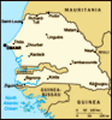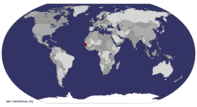Advertisement
Published: November 23rd 2005
Around 2pm on Thursday afternoon, my Gender and Development class left Dakar in two minivans. We were headed for Kaolack, a poor city even by Senegalese standards, in west-central Senegal (check out the Senegal map on the bottom right of this webpage). It used to be a successful peanut growing region, but then the peanut market plummeted in the 70s and 80s, leaving the region with limited means of survival. Consequently, it’s a hotspot of non-governmental organizations (NGOs) and a good place for a fieldtrip.
Since the traffic was so congested, it took 4 hours to get to our rooms in Kaolack. We stayed on the upper story of a nice new building. A collection of woman’s organizations pooled resources to buy it, because they needed space for conferences and meetings. They turned the upstairs into dorm-type rooms to host conference guests and to make some extra money.
After we dumped our stuff in our rooms, we headed back to the vans to go to “Celebrations”, a café in central Kaolack. This place was actually started by an African-American woman who came to Kaolack to retire. Her husband was Senegalese, but he died shortly after the move. She brought
her 5 grandkids with her and home schooled them in her courtyard.
The grandkids friends heard what a good teacher she was, and then their friends heard, and pretty soon 200 kids were crowding into her compound everyday to hear her lessons. So instead of retiring, “Maam” (grandparent in Wolof) went home to the US and raised several thousand dollars. She came back to Senegal and bought a small building. She turned this into a café in order to raise money for her after school program.
The café attracts a lot of business because it is unique in offering American style goods—everything from chocolate chip cookies to chili to pancakes to cheese bread. Besides raising money for the afterschool program, the café serves as a training school for women who weren’t able to finish their education. These girls work as a team to run the café. They choose what to make and how much, cook the food, do the accounting, and plan the advertising. After working there for a while, these women are able to go on to much better jobs than they would have without the experience. After we pigged out on pancakes and cookies, we went
back to the conference center to goof off until dinner.
The next morning we woke up early to start visiting organizations. We would be visiting various groups associated with Aprofes. Aprofes is the umbrella group of a bunch of women’s organizations in Kaolack and the surrounding villages. It also has several programs of its own, including a reception center for female victims of violence, a credit union, and a “health union.” We started our day by visiting one of the member organizations in a suburb of Kaolack.
We got out of the vans and entered a big room with three sewing machines and a circle of plastic chairs. After we sat in the chairs, older women started filing in. The first ones took the few remaining chairs and the rest sprawled onto the mats in the center of the circle. It’s still funny to see old ladies sprawling on the floor like that, even though its perfectly normal for Senegalese ladies.
The president then explained the purpose of the organization. It’s basically a way for women to pull resources in order to get more done. Every founding member had to contribute the equivalent of 20 bucks, which
is a lot for this community. All current members (of which there are 33) have to pay $0.40 a month in dues. The group uses its money to make big purchases that an individual woman would never be capable of making. For example, it has purchased several sewing machines and a machine for grinding millet. Having these machines is a huge timesaver, leaving the women free to pursue other income generating activities. The sewing machines and mill can be used by the women for their households, but all the profit that comes from use by outsiders goes back into the organization.
They use this money to make other purchases which will lead to even more ambitious community projects. They bought the space where we met them in order to have a location for meetings and to house goods. Now they are able to make money by renting the room out for events and by renting out the plastic chairs. The next money making project they plan is to open a
telecentre (basically a manned phonebooth). Since there isn’t one in the village, they could really make a lot of money. Then they could use this money for projects such
as a pump for the well.
After this meeting, we got back in the vans and headed out to a village. It took around an hour to get there, driving on ridiculously pot-holed roads. In fact, the drivers kept the vans on the dirt shoulder whenever possible, because it was smother than the paved road. After a while we turned down a narrow dirt road and followed that to the village. Once again we were greeted by a circle of plastic chairs. There were several Senegalese already seated, including the chief of the village. According to instruction by our professor, we all executed a shallow curtsy in front of him before sitting down. This gathering also started by an extensive ritual of thanks. First the chief spoke for a while, thanking us for coming and thanking the local women’s organization for inviting us. Then the president of the organization spoke. She first apologized for speaking, saying that the chief had already spoken. Then she thanked us for coming. Next, our professor gave profuse thanks to the women’s organization and the entire village for letting us visit.
After the thanks went back and forth a few more times, my

 The well
The well
Hey look! It's my shadow.professor began asking the women questions. The question and answer was in Wolof, and then our professor and our assistant program director translated. We found that this organization was doing pretty much the same as the more urban women’s group. One difference is that their start-up money was a loan from a Kaolack organization, Aprofes. After receiving word that the village women were interested, representatives from Aprofes came to the village to discuss possibilities. Once they decided to form a partnership, Aprofes held a week-long forum in the village. They helped the village women prioritize their needs and helped them come up with some income generating ideas. This is a relatively new collaboration, since 2004. Their main accomplishment to date is the construction of a grain storage facility. People pay a dime a month per sack (millet or peanuts) to keep their goods in this concrete building. Here, goods are safe from the fires that frequently destroy the grass huts.
The main purpose of the storage system is to ration the millet and peanuts. The grains reaped during harvest are the village’s sole source of income. During the months following the harvest, therefore, there is always plenty of grain with which to make exchanges. Every day at 11am, a mobile store comes to the village and offers to trade millet for fish or jewelry or fabric. The women realized that having all their harvest at their fingertips with which to buy this merchandise was too much of a temptation. Several months before the next harvest, everyone would run out of grain, leaving them with no food or means of purchasing food. The women realized that putting the grain somewhere less accessible would help them to better conserve it. Now that the grain is out of sight and a bit of a hassle to get, the women are doing a better job of rationing their only revenue source.
In the future, the women are hoping to get a pump for the well and a small hospital room. As it is, most of the doctoring takes place in the bedroom of the midwife. She’s pushing hard for a new locale. The pump is important because school-age girls are the ones relegated to drawing water from the well. They go to school in the morning then come home to a hard day’s work. It isn’t exactly conducive to learning.
We heard all about the projects underway and why they were a priority. Near the end of our gathering, kids started pouring into the area because school was over for the day. They go to a school several villages away via horse and buggy. They found the crowd of white girls extremely interesting and had to be shooed away by an old lady with a switch. Eventually the settled themselves around the group in an amazingly ordered fashion. We finished the meeting with more drawn-out thanks. After a brief visit to the storehouse, we returned to the vans.
After enduring the jolting ride back to Kaolack, we ate lunch where we’d slept the night before. Our next stop was the
credit mutual, a credit union set up by Aprofes. It was already closed because we were supremely behind schedule, so we just peeked inside. Then we went to the
sante mutual, a sort of “health union”. The director of the explained that the credit union was set up to let individuals and organizations implement far more ambitious projects than they would ordinarily be able to do. These people and groups don’t have the collateral to get an ordinary bank loan but are able to get loans from the credit union.
The managers of the program found that the main reason were having problems paying their bills on time was because of health problems. This led to the health union, basically a really low-priced insurance plan. Members pay a small premium, and then they go to affiliated clinics and pharmacies. The bill is sent straight to the health union. This program has remarkably improved loan payback. After we asked all our questions, we got back in the van and headed back to Dakar.
Advertisement
Tot: 0.173s; Tpl: 0.013s; cc: 11; qc: 70; dbt: 0.1021s; 1; m:domysql w:travelblog (10.17.0.13); sld: 1;
; mem: 1.2mb










Carrie
non-member comment
This is really interesting to me. I didn't know that you were taking a gender and development class. You'll have to tell me all about what the NGOs in the area are doing.